What Does It Mean to Read at University
Week 1: Reading skills for university study
Introduction
A good deal of a student'south time is spent reading textbooks, bookish books, journals, encyclopaedias, newspapers, magazines and websites. These are the sources of information and ideas that are needed to understand a subject area.
Watch the introductory video from the author, Anna Calvi, as she introduces the course and this calendar week:
Download this video clip.Video player: swe_1_wk1_640_hq.mp4
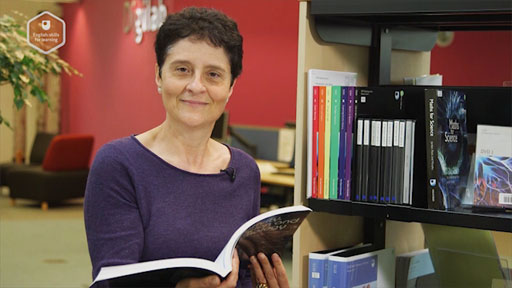
Skip transcript
Transcript
Welcome to Calendar week i. This calendar week you focus on the reading skills that are needed to make the most of a university educational activity. You will look at the unlike sources of data academy students unremarkably read.
University readings can exist long and approaching them can exist daunting. You volition consider some of the challenges students sometimes confront when approaching these readings and acquire an active reading method which allows yous to break a reading job in to small manageable steps. For some activities you will need admission to a printer.
Finally, yous will learn a range of techniques to produce well organised notes that can be used when writing an assignment.
Terminate transcript
Interactive characteristic non available in single folio view (see information technology in standard view).
If you make up one's mind to go to academy, you will accept to prepare for exams and
This calendar week you start by looking at the different texts that university students read. You lot volition so learn to follow an agile reading method that will aid y'all read bookish texts and make notes in the almost constructive way. For some activities this calendar week, and throughout the course, you will need access to a printer.
By the finish of this week, you will be able to:
- place different texts university students read
- understand the most constructive reading strategies
- actively read an academic text
- make useful notes.
The Open University would really appreciate a few minutes of your time to tell the states about yourself and your expectations for the course before yous begin, in our optional start-of-course survey. Participation will be completely confidential and we will not pass on your details to others.
1 Getting started: looking at bookish and specialist sources
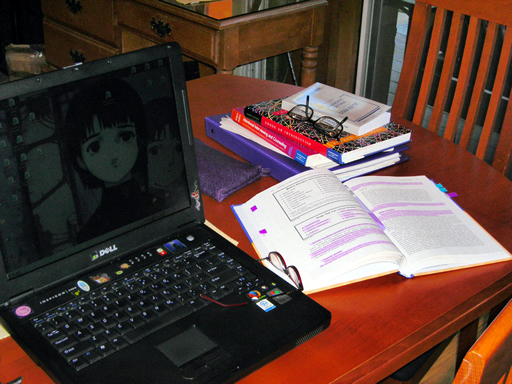
Effigy 1 University students read impress and online texts
In this section, you will consider first the texts you are already familiar with and then the key resources university students demand to read when studying.
These resource provide the information, information, theories and
In order to read and use these sources effectively, it is important to know which types of source they are, what they await like and where they can be found.
1.i What practise yous read?
Reading is an activity many of united states of america are familiar with both at dwelling house and at work. Reading is fundamental to modern life and this means that we are surrounded by texts; that is, pieces of writing such as magazines, text messages and advertisements. The next activity helps you to consider the different texts people read every day.
Activity 1
Timing: Let approximately 5 minutes
Shown below are diverse people's reading habits (Effigy 2). Which of these reading habits are similar to your ain? Brand some notes in the box then read my annotate.
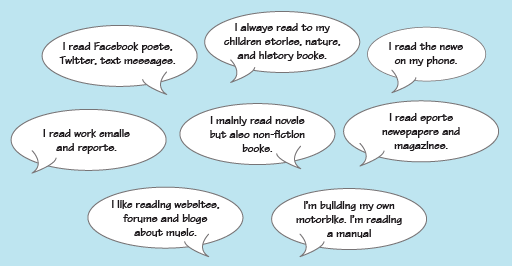
Figure 2 People's reading habits
Interactive feature not available in unmarried folio view (run across it in standard view).
Comment
The answer is personal to you lot, but y'all are probable to read i or more of the text types mentioned above. Reading is likely to already be part of your life and you already know strategies that aid you to read a diversity of texts. This week you will acquire that many of these strategies tin can exist exploited to read university texts and help you to become a more effective reader in full general.
ane.2 What do university students have to read?
University students read textbooks besides every bit other printed or online material. The blazon of material they read depends on the subject field they are studying.
Below are five examples of texts a university student is likely to read. They are frequently bachelor both in impress and online.
You may already exist familiar with some or all of these types of text. Test your noesis in the next activity.
Activity 2
Timing: Allow approximately 5 minutes
Match each source to the description of its content.
Reference material
Facts and figures, addresses, statistics, definitions
Academic journals
The near specialised and up-to-date research, theories and debates in your field of study area, written past academics
Newspapers and magazines
Upwardly-to-engagement developments, current issues and events, written by journalists
Specialist organisations' websites
Online specialist data on a
Academic books
Key principles, facts and theories well-nigh a topic
Using the following two lists, match each numbered item with the correct letter of the alphabet.
-
Reference material
-
Academic journals
-
Newspapers and magazines
-
Specialist organisations' websites
-
Bookish books
-
a.Key principles, facts and theories nigh a topic
-
b.Up-to-appointment developments, current issues and events, written by journalists
-
c.Online specialist information on a
topic -
d.The nearly specialised and upward-to-date research, theories and debates in your subject area area, written by academics
-
e.Facts and figures, addresses, statistics, definitions
The correct answers are:
- i = eastward
- two = d
- iii = b
- iv = c
- v = a
1.3 What academic sources look like
Bookish and specialist sources, such as the ones you have just considered, may have different purposes and comprise different kinds of information but they all aim to present content in a articulate fashion. This is why they all follow a clear and anticipated structure.
The construction of each type of source depends on its purpose. For example, to help readers to discover a specific term easily and quickly, dictionaries conform words and their definitions in alphabetical society. In one case readers understand the way the words are listed, looking upwardly a word is not difficult.
Academic articles or book chapters also follow a articulate and predictable construction. They ordinarily contain an introduction, several paragraphs and a conclusion. Paragraphs may also be grouped into sections. This is their typical structure:
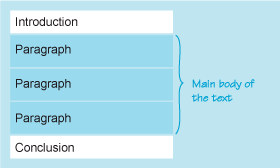
Effigy three The typical structure of a periodical commodity or a book chapter
Activeness 3
Timing: Allow approximately 10 minutes
The components of a typical commodity or book chapter are listed below. Match each component to its definition.
Paragraph
Discusses one specific topic.
Conclusion
Summarises the content of the main body of the text.
Introduction
Mentions the text's content and system.
Master body of the text
Contains paragraphs and sections.
Using the following two lists, match each numbered item with the correct letter.
-
Paragraph
-
Determination
-
Introduction
-
Main torso of the text
-
a.Summarises the content of the main torso of the text.
-
b.Mentions the text'south content and organisation.
-
c.Discusses one specific topic.
-
d.Contains paragraphs and sections.
The correct answers are:
- 1 = c
- 2 = a
- 3 = b
- 4 = d
In this section you lot accept seen how dictionaries, capacity and periodical manufactures are organised. Other texts such equally newspaper manufactures, spider web pages and fact sheets are organised differently. If you enrol on a university course, you will gradually learn to recognise the specific structure of different texts and this knowledge will help yous when you read bookish texts.
1.4 Where information sources are located
So far in this section yous have looked at different types of information. If you become on to written report at university, in your first yr you will generally be provided with the required books and articles and other resources. Later on, you may be required to search for more data or yous may but be interested in finding out more almost a specific topic.
To be able to practice this, you need to know where to notice sources that are relevant to yous. In the next activity, you are shown dissimilar types of information source and asked to decide where they are most likely to be plant.
Activity 4
Timing: Allow approximately five minutes
Some examples of information sources are books, journal articles, references to chapters in books or journals, and daily news. Where would you exist virtually likely to find these items? Choose between:
- libraries
- databases
- cyberspace
- booksellers
- the media.
Note downwards your thoughts (either in the table below or on paper) virtually where you think each item can be constitute, before looking at the answers and comment below. In many cases it may not be a simple 'yes' or 'no', and the items could be institute in numerous places.
Tabular array i
| Libraries | Databases | Net | Booksellers | The media | |
|---|---|---|---|---|---|
| Books | |||||
| Journal manufactures | |||||
| References to chapters in books or journals | |||||
| Daily news |
Interactive feature non available in single page view (see it in standard view).
Reply
Table ane
| Libraries | Databases | Net | Booksellers | The media | |
|---|---|---|---|---|---|
| Books | Yes, and besides in booksellers and maybe on the net | No | Possibly but usually not. | Yes, and likewise in libraries and perchance on the net | Not usually |
| Journal manufactures | Yes, particularly university and higher libraries | Yes, journal manufactures make upward most database content | Yes, sometimes, but check if the journal articles are refereed or not | Not unremarkably | Possibly, but the periodical articles may not be refereed |
| References to chapters in books or journals | Yes, in indexes | Yes | Possibly | No | No |
| Daily news | Yes, libraries usually have daily news items | No | Aye, lots of news sites and e-newspapers | Non likely unless the bookseller sells newspapers too | Yes, besides electronic news sites on the net |
Comment
As you can run into from this activity, depending on their type, these sources tin normally be accessed online, through a library or from a newsagent. Some of these are freely bachelor, but unless you are enrolled in a university caste, you will have to pay or purchase a subscription to view the total version of most specialised books, newspapers, magazines and online journals. These sources are readily available to electric current students through their academy library.
2 Challenges and strategies
Finding the most advisable texts is very important, simply even more important is to make the most of them past reading them in an efficient and effective mode.
In this section yous will consider the master challenges that reading tin can pose and yous will be introduced to some effective strategies.
2.1 The main challenges
Reading textbooks and other academic and specialist sources tin be difficult for a range of reasons. In the post-obit activity, you will consider the primary challenges.
Activity 5
Timing: Allow approximately x minutes
Think back to any long or complex texts yous have read in the past. Your experiences may be from your schoolhouse years or you may take read non-fiction books or long paper articles. What difficulties did you come across? Did you develop any strategies to help you read such texts? Make some notes in the box beneath and then compare your experiences with those reported beneath.
Interactive feature non available in single page view (meet information technology in standard view).
Annotate
Below is a list of some common reading difficulties experienced by some people when reading academic texts.
- I'k used to reading short pieces of writing. When I read long texts, I fall asleep.
- I read textbooks over and over to retain the information. It takes a lot of time and I still notice it very difficult to remember what I read.
- I detect reading difficult and I oft lose concentration.
- I'k used to reading newspapers, but academic texts are harder to read. They are organised differently and contain many hard words.
- English is not my first language, so I have to spend a long time looking up many words in the dictionary.
- Even if I understand every word, I sometimes don't sympathise the
concepts explained in the books I read. - I try to take notes but I'm really lazy at 'proper' note taking – I don't notice it works for me equally I never go back and read them.
- There is so much to read. I get lost and don't know where to start.
Yous may take experienced similar difficulties. You may also accept found ways to help you cope.
Academic and specialist texts may take longer to read than the texts you read every twenty-four hour period and may contain a great deal of information about unfamiliar topics. They may also be structured differently from the texts you normally read. Therefore engaging with pieces of extended writing can be challenging unless you employ useful strategies. The next few activities will help you discover strategies to make reading easier.
ii.2 Effective reading strategies
You are likely to already use some effective reading strategies in your day-to-day life. In this section you will read what some students say almost their reading strategies and so compare them to your ain.
Activeness 6
Timing: Permit approximately 15 minutes
Information technology is useful to learn some strategies from people who are already reading academic texts.
Read what some electric current university students say about the style they read textbooks and other bookish texts. Then reply the questions that follow.
- A.For my module, I accept to read many chapters and articles. To keep concentrated, I always effort to find a skilful reason for reading. I good reason is to read in order to find answers to the
consignment question, but I oftentimes remember of my ain questions. And so earlier I first reading about a topic, I think about what I already know about it and what else I would like to know. Sometimes the materials give you some questions to consider while reading.- B.I think it also helps to read the introduction very advisedly. It tells you what the chapter volition be about and what you will exist able to do after reading it. I find that it gives me the motivation to read.
- C.A proficient way to concentrate and retrieve what I read is to keep looking for ideas and examples that are relevant to me. So while I read, I ask myself: Does this happen to me or to people I know? Have I ever seen this? Do I agree? … It too helps to discuss what I have read with other students.
- D.I remember it'south important to read actively. I read the key texts more than once. First I just check how long a affiliate is, its headings, sections, images, and and so I read it quickly to get a general idea, the
gist . When I know what the text is most, I read the fundamental parts more carefully making notes. I find that making notes is a really adept mode to remember the content of the texts. I like using diagrams and tables and lots of colour. It helps me organise my ideas and retrieve what I read.- Eastward.I don't read all the texts in the same style. Sometimes, I just demand to find a specific slice of information, for example a date or a particular topic, and so I just read it quickly to find this data. Just if, for example, I have to read about a complex theory, I will read very carefully and more than once.
Question one
The students mentioned a variety of strategies but there were other useful ones they overlooked. Read the list beneath and try to identify which strategies weren't mentioned. Listing them in the box with a note about why you remember the strategy could be useful. And then compare your list with mine.
- Always read for a purpose.
- Earlier reading, ask yourself what you already know and what you want to learn virtually the topic.
- Write downward some questions yous hope the text will answer.
- Earlier reading a textbook chapter, check the learning outcomes.
- While reading, try to discover data and theories that are relevant to you.
- While reading, keep asking yourself questions.
- As you read, record your thoughts in the margin or in a notebook.
- Read the same text ii or three times. More may exist necessary.
- Check the structure of the text before reading.
- When yous read for the first time, look upward just the words that are essential for understanding the text.
- When y'all read the 2d time, make notes.
- Try to employ other information in the text to make sense of difficult words.
- Read differently depending on the purpose for reading.
Interactive feature not available in single page view (run across it in standard view).
Respond
The following strategies were not mentioned:
- Write downwardly some questions you hope the text volition answer. The student said they just think of some questions, merely writing down those questions will help you to focus and structure your notes.
- As yous read, tape your thoughts in the margin or in a notebook. This is a skilful mode to concentrate while reading. Sometimes your thoughts could be simple questions, such every bit 'Why?' or 'How?', which may make yous want to reread certain parts or look for answers farther in the text.
- When you lot read for the kickoff fourth dimension, look upward just the words that are essential for agreement the text. This is sound communication: if you wait up every word, yous will probably lose track of what you are reading. Information technology might be amend to read whole paragraphs again to empathize the full general significant before looking upwardly words in the dictionary.
- Try to use other information in the text to make sense of difficult words. Sometimes the text in which these words are used tin can help y'all to understand their meaning.
Question 2
Read the list of reading strategies over again.
- a.Which of the strategies do you already follow?
- b.Which of them is new to you?
- c.Which would y'all similar to effort?
Make some notes in the box below.
Interactive feature non available in unmarried folio view (see it in standard view).
Comment
You may already be following many of the strategies mentioned past the students. For case, many of u.s. look at the length and construction of a text before reading it and it is normal to accept to reread longer documents. The strategies mentioned by the students tin can aid you to extend the skills you already have.
Making utilize of reading strategies can help to overcome the challenges faced when reading long and circuitous texts and, in particular, bookish and specialist sources. They can too help y'all to read more than actively. Through the adjacent few activities you will larn and practise an agile learning method.
3 Reading actively
Being active every bit a reader is a skilful manner to become more good and exist able to take on more than enervating texts.
In this department yous will larn how to follow an active reading method consisting of five steps:
-
Skimming the text. - Recalling your groundwork knowledge about its topic.
- Scanning for specific information.
- In-depth reading to find the key points.
- Making sense of texts containing difficult words.
These steps are outlined in the side by side v subsections and each has an activity associated with it. Some of these activities are based on the same slice of text. You will need access to a printer to impress out that text in society to piece of work on it.
3.i Skimming the text
This reading strategy consists of reading the text apace in club to notice out what information technology is about and how information technology is organised. This can exist done by reading its introduction as this is probable to briefly say what the text volition be about. Titles, headings and subheadings besides demand to be read because they innovate the text and its sections and subsections. Visual representations of the content, such as images, diagrams and tables, can be used for the same purpose.
Finally, it is also very useful to read the commencement sentence of each paragraph. This judgement, which is called the topic sentence, is commonly the outset sentence of each paragraph and announces its topic.
Therefore, to quickly obtain data most the text, you tin can:
- read the championship, the introduction, whatever headings and subheadings, and the conclusion
- read the start sentence of each paragraph (the topic sentence)
- read the concluding sentence of each paragraph
- read the words highlighted in bold
- await at illustrations (pictures, diagrams, tables).
As texts differ, y'all may not be able to follow all these strategies all of the time when skimming a text. For example, not all texts have illustrations or headings, and some brusk texts and extracts may not finish with a conclusion.
To practise skim reading you are going to read a text taken from the Open Academy class KG004 Improving health and wellbeing. Download the text now.
Activity 7
Timing: Let approximately 10 minutes
Read only the introductory paragraph, the headings and the topic sentence of each paragraph. Then answer the questions that follow. I recommend printing out this text every bit you volition refer to information technology again while working through the adjacent few activities.
Question i
Having skim read the text you should now have an overview of the information it contains. To see if you lot take, try to match the post-obit statements to the paragraphs in which they were mentioned.
Paragraph 5
Over-nutrition in rich and poor countries
Paragraph 2
Nether-nutrition in rich and poor countries
Paragraph vi
Negative effects of eating highly nutritious foods
Paragraph vii
Definition of type 2 diabetes
Paragraph three
Furnishings of low calorie diets in children
Paragraph 4
Causes of under-nutrition
Using the post-obit two lists, match each numbered item with the right alphabetic character.
-
Paragraph 5
-
Paragraph 2
-
Paragraph six
-
Paragraph seven
-
Paragraph three
-
Paragraph 4
-
a.Under-nutrition in rich and poor countries
-
b.Definition of type 2 diabetes
-
c.Over-nutrition in rich and poor countries
-
d.Negative effects of eating highly nutritious foods
-
e.Causes of under-nutrition
-
f.Effects of low calorie diets in children
The correct answers are:
- one = c
- 2 = a
- 3 = d
- 4 = b
- 5 = f
- 6 = east
Question 2
Having skim read the text, which of the following headings best describes the topic of the whole text?
- Health issues in developing countries
- Forms of malnutrition
- Solutions to malnutrition
Answer
The correct answer is 2. Forms of malnutrition. The text is most the two forms of malnutrition: under-nutrition and over-diet.
Incorrect answers
-
Health problems in developing countries.
The text is not most health issues in general, but more specifically nearly nutrition. It considers malnutrition in both developing and developed countries.
-
Solutions to malnutrition.
None of the headings or the topic sentences mentions solutions. The introduction mentions the two forms of malnutrition and their furnishings.
Through skim reading you have learned a quick way to observe what the text is about and how it is organised. This information will help you determine what to read: all the text or just some sections. You lot will also be able to make up one's mind how you want to read the text.
3.2 Recalling your background knowledge most its topic
Then far, you take gained information about the overall topic and organisation of the text. If your aim is to report this text in depth, you will now be able to recollect your personal cognition about its topic and think of questions yous hope the text will answer for y'all.
Activity 8
Timing: Allow approximately x minutes
Now spend a few minutes thinking most the text you read in Activity 7. Think well-nigh:
- what yous already know about its topic
- any questions you think the text might answer.
Write a list of facts, ideas or questions beneath each of the following headings. I accept started the lists for you.
Under-nutrition
Interactive characteristic non available in single page view (meet information technology in standard view).
Over-nutrition
Interactive characteristic not available in single folio view (see it in standard view).
Answer
The reply is personal to you, but here are some notes:
Under-nutrition
- Not eating enough
- Which nutrients are essential to avoid under-nutrition?
- Inudstrialised countries? — Causes?
Over-nutrition
- Eating too much
- Obesity
- More than furnishings?
Comment
Depending on your previous knowledge of the topic of this text, you may have listed facts, ideas and questions or but questions. Fifty-fifty if you listed just questions, you lot now have a purpose for reading the text: you are likely to want to compare your previous knowledge with the findings reported past the text and to observe answers to your questions. Academy students may also want to read this text before writing an
3.3 Scanning for specific information
Having learned what the text is most and how it is organised, you may decide non to read information technology in depth merely to only record some of the very specific information it contains. Ane reason for doing this may be because you are already familiar with the theme of the text and just need some details. In order to find this specific information, you need to scan the text.
Scanning consists of letting your optics move speedily through the text until you find what y'all are looking for. Equally long as you know how the text is organised, this can be done quickly and without reading every word.
This is a technique many of us use every day. For instance, I may scan the telephone directory to find a proper name. Or when I go to a restaurant, I scan the menu to find the vegetarian options.
Scanning texts is easy if you are familiar with their organisation. For instance, I know that the menu of my favourite restaurant lists the main grade under the heading 'Mains', so I scan this list looking for the word 'vegetarian', 'vegetable' or simply 'V'.
In academic texts data is oftentimes grouped under headings, so to find a specific detail, you lot demand to first locate the appropriate heading. If there are no headings, retrieve that the topic sentence of each paragraph is like a heading, every bit information technology tells you what the paragraph is about. In a paragraph, details can usually be found in the sentences that follow the topic sentence so this is where yous need to expect.
When you think y'all take institute the relevant section or paragraph, look for key words or figures.
You volition practice this skill in the following activity.
Activeness 9
Timing: Allow approximately ten minutes
Using the understandings you gained from skim reading the text in Activeness 7, quickly scan the text again to reply the following questions. Make your notes in the box below before looking at the answer.
- How many children are underweight?
- What percentage of children dice because of under-nutrition?
- What diseases are caused by over-nutrition?
- Who develops blazon 2 diabetes – adults or children?
You lot will need to first select the relevant department. To answer questions 1 and 2, expect for numbers and percentages. To answer questions 3 and four look for specific words.
Interactive feature not available in unmarried page view (see information technology in standard view).
Answer
To reply these questions successfully you needed to look for numbers and percentages as well as words describing diseases and the words adult and child.
- 100 million [P3].
- 35% [P3].
- Coronary heart disease, type two diabetes, gallstones, arthritis, high blood pressure level and some types of cancer [P6].
- Both adults and children [P7].
Comment
This activity has shown that having gained an overview of a text, it is oft possible to search for specific information past scanning it. This technique is very useful when you don't need to read the text in depth. As y'all will meet in the post-obit section, if y'all wish to gain a full understanding of the text, you volition demand to read it again in depth while focusing on the main points.
3.four In-depth reading to discover the key points
If, after skimming the text, you lot make up one's mind to read it more than closely and proceeds an in-depth understanding of its topic, the adjacent step consists of reading the full text and identifying the cardinal points. An constructive manner to identify key ideas is to highlight important parts of the text past underlining or using a highlighter pen.
This approach is designed to select and focus just on the cadre meanings of an extract. Highlighting involves making judgements almost what is important. It is not most capturing every detail but getting a general overview of the key ideas.
Therefore, information technology is important to highlight only very few words and phrases in each paragraph. Paragraphs usually focus on ane central point and, while they may include an illustrative example that may be useful, information technology is the main indicate that you demand to identify first and foremost.
To illustrate this technique, I take highlighted the starting time two paragraphs of the text on malnutrition. (To exist readable on screen, they are shown in bold rather than really 'highlighted'.)
[P1] To stay good for you, the body'south needs for energy and nutrients must be met. This is specially of import in growing children as damage inflicted may not be reversible and can bear on normal development. People whose diet lacks the necessary nutrients suffer from malnutrition, a condition that includes both over-nutrition and under-nutrition and is considered a risk factor for health.
Under-nutrition
[P2] Nether-nutrition is in news reports of famines in poor countries, but it tin likewise be establish in adult countries. In industrialised countries, under-nutrition can be seen in young people who have eating disorders such every bit anorexia nervosa or bulimia, where the amount of energy they swallow in food is less than the needs of their body.
As you tin can meet, in the start paragraph I accept only highlighted the word 'malnutrition' and words that assistance to define information technology. In the second paragraph, I accept highlighted words that refer to the location of under-nutrition (poor countries, industrialised countries), information about under-nutrition in industrialised countries (immature people, eating disorders) and a definition of nether-nutrition. I have non highlighted the examples.
You will find that more words and phrases demand to be highlighted if a paragraph contains a great bargain of core information. This is why several words and phrases are highlighted in paragraph 2.
The next activeness gives you lot the opportunity to practice highlighting a text. Y'all volition need to print out the text and have a pen or highlighter pen handy.
Activity 10
Timing: Allow approximately xv minutes
If yous oasis't already done so, download the text on malnutrition you skim read in Activity 7 and print it out. Read Paragraphs 3 to 7 and underline or highlight the key points they make. If y'all find new words, at this stage just await them up if they are essential to understand the overall significant of a sentence. When you have finished, compare your highlighted text with mine.
Note: You lot volition return to this text in a later activity and so delight keep your highlighted copy.
Respond
The central points are highlighted (in bold).
[P1] To stay healthy, the torso'due south needs for free energy and nutrients must be met. This is particularly important in growing children as harm inflicted may non be reversible and can touch on normal development. People whose nutrition lacks the necessary nutrients suffer from malnutrition, a condition that includes both over-nutrition and nether-diet and is considered a risk factor for health.
Nether-diet
[P2] Under-nutrition is in news reports of famines in poor countries, but it can also be found in developed countries. In industrialised countries, under-nutrition can exist seen in young people who have eating disorders such as anorexia nervosa or bulimia, where the corporeality of energy they consume in nutrient is less than the needs of their body.
[P3] If children's diets are besides low in energy, they will terminate growing and gaining weight. They will become lethargic, less agile and be unable to concentrate. If the situation continues, they may develop life-threatening diseases. The Nutrient and Agriculture Arrangement of the United nations (2012) reports that 100 1000000 children nether the age of 5 are underweight and 35% of all deaths of children under five are caused by malnutrition.
[P4] When people endure from under-diet, they are oftentimes scarce in vitamins and minerals needed by the body. For example, they may non accept enough Vitamin A. If this deficiency is not tackled, eyesight may be permanently damaged. Lack of iron is some other very mutual course of deficiency. This helps to explain why about 50% of women in India suffer from some degree of anaemia.
Over-nutrition
[P5] Over-nutrition is usually associated with industrialised countries, although it is now also a problem amidst affluent people in developing countries. The main trouble is that the corporeality of energy consumed in food is greater than the needs of the body and this can issue in people condign overweight or obese. Every bit with under-nutrition, this may lead them to become lethargic, less agile and less able to concentrate.
[P6] Farther wellness problems will arise over time, particularly if the diet is high in saturated fat. Saturated fatty is solid at room temperature; examples include animal fats, dairy products and coconut and palm oil. Eating a nutrition loftier in saturated fat raises claret cholesterol and the adventure of heart illness. People who are overweight or obese are more than likely to suffer from coronary heart disease, blazon two diabetes, gallstones, arthritis, loftier blood pressure and some types of cancer.
[P7] Type ii diabetes is a metabolic disorder in which the torso has problem making its own insulin to control the level of sugar in the blood. Because information technology tends to develop in adults, it is also known every bit adult-onset diabetes. Notwithstanding, growing numbers of young adults and children are at present developing information technology.
Comment
The number of words and phrases that you chose to highlight may differ from mine because we may have different perceptions regarding what is important in this text. However, we probably concord that the cadre information includes the types of people afflicted likewise as the definitions, location, causes and effects of under-diet and over-nutrition.
What yous highlight also depends on your purpose for reading. For example, if I were only interested in details about the likely effects of malnutrition, I would underline the examples as well.
3.5 Making sense of texts containing difficult words
An bookish text may contain many words you don't know, but it may still be possible to understand its content by following a range of strategies. Y'all may already exist familiar with these strategies as it is quite common, when coming beyond new words in everyday life, to effort to work out their meaning from the context in which they are used. This context may include, for example, the pictures and other words that environs the text.
The advert shown in Figure 5, for example, contains terms I don't fully sympathise, such every bit emphysema, simply the other words in the listing, the movie and my general knowledge most smoking assistance me understand that it must be a deadly disease. This contributes to my overall understanding of the message conveyed by the advertisement.
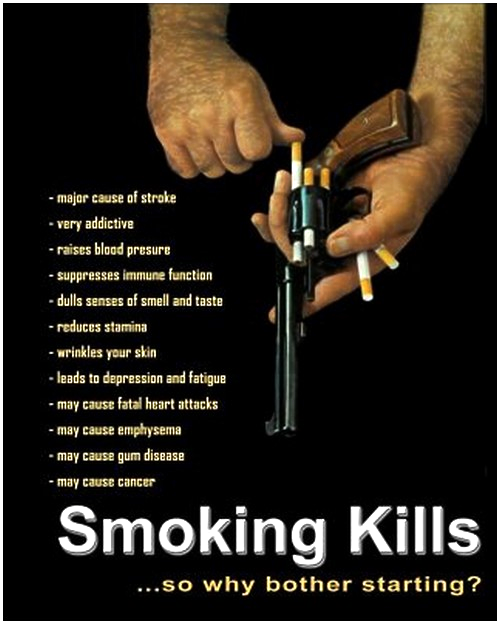
Figure 5 Anti-smoking advert
Rather than looking up every word in the dictionary, experienced readers make sense of new words past cartoon on the following strategies:
- their groundwork noesis almost the topic
- the context in which a discussion is used: the words, sentences and examples that follow information technology
- their understanding about the way in which words are synthetic in English
- their knowledge of other languages. Many academic words will be familiar if you take some knowledge of French or another language derived from Latin.
You will practise these strategies in the post-obit activity.
Activity 11
Timing: Allow approximately 10 minutes
Read the scenario below. What strategies could you utilise to help the student? Make some notes in the box below earlier looking at the answer.
Scenario
A young man student is struggling to fully sympathize the following extract because it contains some words that are new to him. How might yous help him use both his full general knowledge virtually language and the context to sympathise the meaning of the words in bold?
Extract
When people suffer from under-diet, they are often deficient in vitamins and minerals needed by the body. For case, they may not have enough Vitamin A. They volition become lethargic, less active and be unable to concentrate. If the situation continues, they may develop life-threatening diseases. The Nutrient and Agriculture Arrangement of the United Nations (2012) reports that 100 million children under the age of v are underweight and 35% of all deaths of children nether five are caused past malnutrition. People who are overweight or obese are more likely to endure from coronary heart affliction, type 2 diabetes, gallstones, arthritis, high blood pressure and some types of cancer.
Interactive feature non bachelor in single page view (see it in standard view).
Answer
Scarce
To empathise this word you could apply two strategies: context and knowledge of other languages. The word deficient becomes articulate if yous read the text effectually information technology. In other words, read the context in which deficient is used – in this case the example that follows. An case of a person who is deficient in vitamins is a person who doesn't have Vitamin A. So deficient means 'doesn't have' or 'lacks'.
Yous could besides draw on whatsoever cognition you have of other languages. Deficient has very similar French, Spanish or Italian equivalents, so speaking these languages may help.
Lethargic
Lethargic is included in a list of other words so context once again would be a useful strategy. Fifty-fifty if y'all don't understand its meaning, from the context you will probably understand that lethargic describes 1 of the effects of malnutrition. This may be sufficient unless you want to read the text in more than depth.
Life-threatening
2 strategies could be used to empathise this word: context and separating the discussion into its two parts. The sentence that follows the i in which life-threatening is used provides more information every bit information technology explains that these children die. This means that life-threatening diseases are diseases that tin cause loss of life.
You may also consider using your noesis of other English words. Life-threatening is ii words that tin can be understood separately – life and threatening.
Underweight
The strategy here is to recognise that underweight is made up of two words: nether and weight. If you empathise them separately, you may exist able to understand that this word means less than the normal weight. Words such as under, over, mid- (as in midday), sub- (every bit in submarine) and un- (as in unfriendly) are called affixes and are often added to other words to change their meaning.
Gallstones
Again, context would exist a useful strategy. From the context in which this word is used, it is possible to empathize that this is a illness as it is office of a list of diseases from which obese people may suffer. Depending on the purpose for reading this text, yous may determine that it is non essential to understand the word in order to gain a total understanding of this text.
The ability to use these strategies comes with practice. You may desire to read regularly and employ a paper or an online dictionary to await upwardly simply essential and fundamental terms. If English is non your kickoff language, information technology is as well useful to read online news and adept quality English language language newspapers regularly. For example, you could try reading the news from i of the post-obit websites:
In this section you have looked at an active reading method consisting of five steps. If your purpose for reading is to place useful information that can be used in an essay or revised earlier an examination, you volition also need to make notes. Annotation-making techniques are explained in the next department.
four Making notes
Once yous have identified the key ideas in a piece of text you are in a position to brand some brief notes or jottings to prepare for an essay or to call up what you lot take learned from the commodity. Indeed, yous may find that highlighting on its own may non help you to remember the ideas that you identified. Rather than returning to the highlighted text every time you lot want to revisit these ideas, only to detect that what you take marked does non brand sense to you whatever more, it is useful to develop a form of note taking.
The next activities give you an opportunity to practise notation taking by:
- adding curt notes into the margins of the highlighted text
- making notes in a notebook.
four.1 Calculation curt notes in the margins of highlighted texts
This type of annotation making can exist used while reading and underlining the text. Withal, to gain a better agreement of the text, you may want to read it again and use this opportunity to add notes in the margin. These notes can consist of:
- key words
- definitions
- translations of new words
- comments
- reference to related resources
- questions.
When making short notes you need to be concise. Trying to become everything down is very time consuming and can result in notes as long as the article itself. One way to save time and keep your notes as brusque as possible is to make use of symbols, shorthand and abbreviations. Y'all probably already know some curt forms and you can add any others that you make up. A whole range of symbols and abbreviations can exist used, some of which are reproduced below (Figure half-dozen).
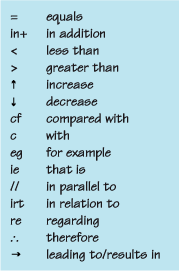
Figure 6 Examples of symbols and abbreviations that can exist used for note making
In addition, you tin can utilise your own form of autograph, which sometimes entails leaving out vowels or cutting off the ends of words. This method is peculiarly effective where longer words are concerned. For example, full-bodied becomes conc., advantage and disadvantage go adv. and disadv. respectively, and consequently becomes consq. Developing your ain autograph that makes sense to you lot can be extremely time efficient and after a while it becomes a language of your own that flows easily from the pen.
Figure vii shows an annotated paragraph. The annotations reproduce the highlighted text using abbreviations. For case, NRG has been used to abbreviate energy and cntry to abbreviate countries.
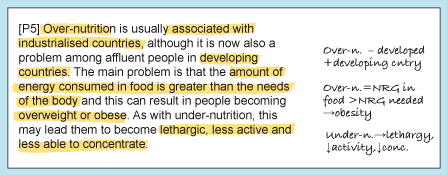
Figure 7 Instance of an annotated paragraph
Equally you read, you may likewise want to add together annotations that help to define new words, inquire questions or refer to specific pages in other sources. In addition, while making sense of the text, some readers may add annotations that help to explicate ideas and relationships, or add together an example that they may not highlight only that all the same needs to be understood or may be useful at a later date. This is illustrated in Figure 8.
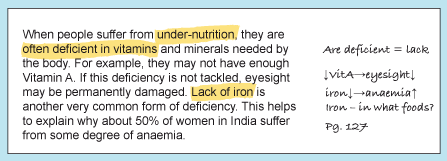
Figure eight Example of an annotated text
If you don't mind writing on hard re-create or in books, this method of note making can be effective. As space is express, this technique encourages you to be selective and reduce the key data to just a few words and/or symbols. Thinking of and recording questions helps y'all to predict and set up for the content of the following paragraphs and therefore process the information they contain.
4.2 Making notes in a notebook
Getting primal ideas down in shorthand course is also useful when making notes in a notebook. Y'all will practise this technique in the post-obit activeness.
Activity 12
Timing: Allow approximately 10 minutes
Read the 'Improving health and wellbeing' text once again and make some brief notes. Endeavor to write equally concisely as yous tin. For example, these are the notes I made after reading the first paragraph (Effigy 9).

Figure 9 Author's notes against paragraph i of practice text
After y'all stop making your notes compare them with mine.
Interactive characteristic not available in single page view (run across it in standard view).
Answer
Figure 10 shows the notes I made on the text.
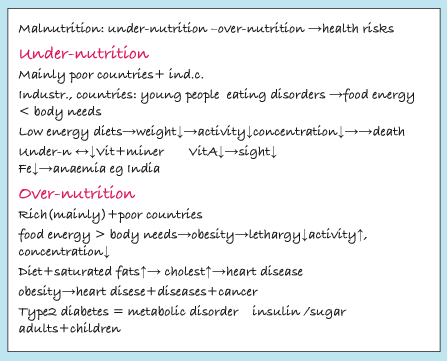
Figure 10 Author's notes on the practise text
This strategy is constructive because it forces yous to select the most of import information and, in particular, the information that will help you to write your essay or prepare for an test.
The drawback with this strategy is that these notes just reproduce the central ideas in the order followed by the original text. To gain a deeper understanding of the text and to remember the fundamental information information technology contains, y'all need to reorganise your notes in a way that is meaningful and memorable to you lot.
five Reorganising notes
To remember the content of your notes, it is useful to process and reorganise the ideas they contain. This is specially useful for those notes that yous will be drawing upon for planning and writing assignments. They tin can be reworked and fundamental concepts and ideas tin can exist practical to different types of question and issue.
Means of processing and regrouping ideas include:
- organising information into subtopics
- using a
mind map - using a table.
Each person finds the ways that are most useful for them and that all-time fit each text they read. You may need to experiment with different methods to find the ones that suit you lot. The activities contained in the next three sections provide opportunities to do this. If yous accept time endeavour all three; otherwise try the method you are least familiar with and merely await at my answers to the other two activities.
5.1 Organising information into subtopics
Rather than writing notes that list the information in the society followed by the source text, you may determine to utilise your ain arrangement. You volition practise this in the following activity.
Activity 13
Timing: Let approximately 10 minutes
As you lot saw in previous activities, the practice text provides data almost causes, effects and location of over-nutrition and under-nutrition. Focusing on these topics tin can assist you to reorganise your notes.
Get over the practice text and your previous notes again and organise the information using the headings below. Where useful, you may want to include some examples. To increase the effectiveness of these notes, endeavour to employ very curtailed expressions.
When you finish compare your work with my answer. You tin brand your notes either in the boxes provided beneath or on paper if you prefer.
Interactive feature not available in unmarried page view (see it in standard view).
Interactive feature not available in single folio view (see it in standard view).
Answer
My respond contains information I felt would be useful when discussing the topic of malnutrition. You may have chosen slightly dissimilar information.
As yous see, I have used very concise expressions. Reducing data to concise expressions is a skill y'all will practise in Week 8.
Under-nutrition
Causes:
Eating disorders (in adult countries): anorexia, bulimia
Low energy diet
Scarcity of food (dearth)
Furnishings:
Lethargy, low activity levels, low concentration
Stunted growth, weight loss
Long term/in children: diseases leading to decease
Vitamin (e.g. Vit A→sight loss) and mineral (e.g. iron→anaemia) deficiency
Where?
Developing countries – more often than not
Adult countries
Over-diet
Causes:
Excessive food intake
Saturated fats-rich diets (dairy products, beast fats, coconut/palm oil)
Furnishings:
Lethargy, low activity levels, low concentration
Weight gain, obesity
Effects of obesity: coronary heart illness, gallstones, arthritis, cancer, type 2 diabetes, high blood pressure
Type two diabetes: metabolic issues, mostly adults+children
Where?
Developing countries – mostly
Developed countries
5.2 Using a heed map
If y'all prefer to create a visual representation of the central ideas contained in the texts yous read, y'all can use a heed map. A listen map is a diagram showing a key idea and other associated ideas and information. The fundamental thought is at the centre of the diagram and the other concepts stem from it.
Activity 14
Timing: Allow approximately xx minutes
Below is a mind map whose branches show the main topics dealt with past the 'Improving health and wellbeing' text. As you lot tin meet, there are two chief branches that chronicle to the two main topics: over-nutrition and under-nutrition. From each of these branches stem three sub-branches that relate to the three primary subtopics: causes, effects and location.
Download a PDF of this mind map then print information technology out. Populate this heed map by calculation more than branches to the iii sub-branches. You can reuse the same words used in the answer to Activity 13 or your own words. Notwithstanding, as infinite is limited, yous will demand to exist very curtailed and you lot may desire to omit some less essential information.
When you have finished, compare your mind map with mine.
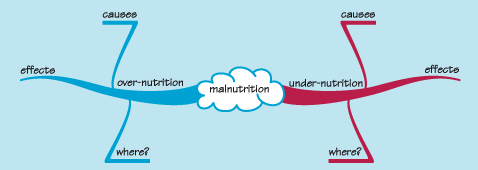
Figure 11 Partially filled in mind map
Respond
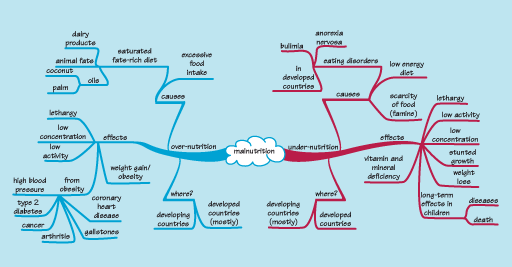
Figure 12 Completed mind map
Some people find diagrammatic representations, such equally mind maps, tin exist more memorable, especially when revising for exams. However, due to lack of space, it is not e'er possible to enter every detail in a heed map. For example, my mind map does not contain details about blazon 2 diabetes. I left it out because space was limited and I felt that this detail was non essential.
v.3 Using a table
Information taken from the texts you lot read can also exist reorganised using a table. A table is particularly useful in reorganising the 'Improving wellness and wellbeing' text, considering information technology allows y'all to easily compare the causes, the effects and the location of the two forms of malnutrition. Compared to a heed map, a table allows you to include more data.
Activity 15
Timing: Allow approximately 10 minutes
Make a copy of the table below and use it to enter information contained in the 'Improving health and wellbeing' text. Yous may want to reuse the same words used in the reply to Activity thirteen or your own words.
Table ii
| Under-nutrition | Over-diet | |
|---|---|---|
| Causes | ||
| Effects | ||
| Where? |
Respond
These are the points I felt would be useful when planning and writing an essay. You may take chosen dissimilar ones.
Table iii
| Under-diet | Over-nutrition | |
|---|---|---|
| Causes |
|
|
| Effects |
|
|
| Where? |
|
|
This section has introduced you lot to three ways to reorganise information taken from the texts you read. The mode you reorganise ideas depends on the content of the text. For example, the organisation and content of the practice text nigh malnutrition lent itself to all three methods.
Additional questions, ideas and examples can exist added at a later on date. For instance, if you get a university student, you will want to make links to ideas presented elsewhere in your course materials, or something y'all take read in a paper might provide yous with a useful illustration. It is a proficient thought, then, to get into the addiction of revisiting your notes at intervals throughout your studies to develop links, introduce new questions and examples, and thus continually reprocess key ideas.
half-dozen This week's quiz
Well washed, y'all've simply completed the last of the activities for this calendar week'south study before the weekly quiz.
Go to:
Week one practice quiz.
Open the quiz in a new tab or window (by holding ctrl [or cmd on a Mac] when y'all click the link).
7 Summary
This week you have looked at the types of text that academy students need to read and at the most effective reading and note-making strategies.
These are the almost of import learning points:
- University students need to read books, journals, specialised websites and reference texts.
- Reading academic texts can be difficult and requires a strategic approach.
- It is important to have a reason for reading.
- The most constructive strategy consists in reading actively.
- Skimming, scanning and predicting the content of the text are active reading techniques.
- Skimming helps to decide how you desire to read a text.
- Underlining words and/or phrases helps yous to select and focus on the key points in a text.
- Difficult words can sometimes exist guessed from the context.
- Calculation notes in the margin and writing brief jottings are useful note-making techniques.
- To call back the content of your readings, information technology is useful to reorganise your notes using headings, mind maps and tables.
Yous tin at present go to Week ii.
References
The Open Academy (2014) 'Science File', KG004 Improving wellness and wellbeing, Milton Keynes, The Open up University.
Acknowledgements
This class was written by Anna Calvi.
Except for third party materials and otherwise stated (run intoFAQs), this content is made available under a Creative Commons Attribution-NonCommercial-ShareAlike 4.0 Licence.
The material acknowledged beneath is Proprietary and used under licence (not subject to Artistic Commons Licence). Grateful acknowledgement is made to the post-obit sources for permission to reproduce material in this unit of measurement:
Images
Figure 1: Desk, © javaturtle on Flickr made bachelor under https://creativecommons.org/ licenses/ past-nc-sa/ 2.0/; Figure 4: Child writing/drawing © Henry Burrows (Foilman) on Flickr made bachelor nether https://creativecommons.org/ licenses/ by-sa/ 2.0/ deed.en; Figure 6: http://www.moolf.com/ amazing/ tiptop-10-anti-smoking-ads.html.
Every effort has been fabricated to contact copyright owners. If whatever have been inadvertently overlooked, the publishers volition be pleased to make the necessary arrangements at the start opportunity.
Don't miss out:
one. Join over 200,000 students, currently studying with The Open up Academy – http://www.open.ac.uk/ cull/ ou/ open-content
two. Enjoyed this? Find out more nearly this topic or browse all our free grade materials on OpenLearn – http://world wide web.open.edu/ openlearn/
three. Outside the UK? We have students in over a hundred countries studying online qualifications – http://www.openuniversity.edu/ – including an MBA at our triple accredited Concern School.
Week 2
Source: https://www.open.edu/openlearn/ocw/mod/oucontent/view.php?id=19202&printable=1
0 Response to "What Does It Mean to Read at University"
Publicar un comentario